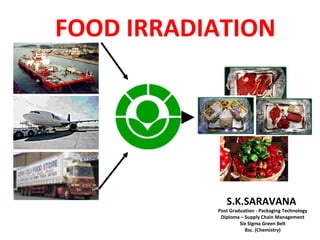Food Irradiation_S.K.Saravana
- 1. FOOD IRRADIATION S.K.SARAVANA Post Graduation - Packaging Technology Diploma ŌĆō Supply Chain Management Six Sigma Green Belt Bsc. (Chemistry)
- 2. HISTORY OF FOOD PRESERVATION OLD METHODS NEWER METHODS - Drying - Refrigeration - Fermenting - Freezing - Salting - Canning - Smoking - Preservatives Latest Method: IRRADIATION S.K.SARAVANA sarvanpackaging@gmail.com
- 3. FOOD IRRADIATION ŌĆó Food Exposed to Controlled Energy (Ionizing Radiation) ŌĆō Gamma Rays (bulk foods on shipping pallets) ŌĆō X Rays (deep penetration, requires shield) ŌĆō Electron Beam Radiation (shallow penetration) ŌĆó Radiation Kills Microorganisms w/o Raising Food Temperature ŌĆó Does not and cannot make foods radioactive S.K.Saravana sarvanpackaging@gmail.com
- 4. HISTORY OF FOOD IRRADIATION ŌĆó Approved for potatoes by Canada in 1960 ŌĆó 1963 First FDA approval for insect control in wheat flour ŌĆó 1964 - Dehydrated vegetable seasoning ŌĆó 1986 - Fruit and vegetable ripening ŌĆó 1990 - Fresh and frozen poultry to control salmonella and other pathogens S.K.Saravana sarvanpackaging@gmail.com
- 5. HOW IS FOOD IRRADIATED? S.K.Saravana sarvanpackaging@gmail.com
- 6. EFFECTS OF FOOD IRRADIATION ŌĆó Prevent Food Poisoning By Reducing ŌĆō E. Coli )157:H7 (Beef) ŌĆō Salmonella (Poultry) ŌĆō Campylobacter (Poultry) ŌĆō Parasites ŌĆó Prevent Spoilage by Destroying Molds, Bacteria and Yeast ŌĆó Control Insects and Parasite Infestation ŌĆó Increase Shelf Life by Slowing Ripening of Fresh Fruits and Vegetables S.K.Saravana sarvanpackaging@gmail.com
- 7. WHAT ARE THE FOOD IRRADIATOR SOURCES? ŌĆó Cobalt-60 and Cesium-137 ŌĆō Emit gamma rays ŌĆō Sealed in container - never touches food ŌĆō Can be recycled ŌĆó Beta or X-rays ŌĆō Produces no waste outside of the machine used to produce the radiation S.K.Saravana sarvanpackaging@gmail.com
- 8. IRRADIATION PROCESSES ŌĆó Sterilization ŌĆó Pasteurization ŌĆó Disinfestation ŌĆó Sprout Inhibition ŌĆó Delay of Ripening ŌĆó Physical Improvements S.K.Saravana sarvanpackaging@gmail.com
- 9. IRRADIATION STERILIZATION ŌĆó Very high dose used to kill all organisms ŌĆó Sterilization of > 50% disposable medical instruments ŌĆó Food sterilization ŌĆō NASA & BARC S.K.Saravana sarvanpackaging@gmail.com
- 10. IRRADIATION PASTEURIZATION ŌĆó Reduces remaining number of living organisms ŌĆó Prevent growth of mold ŌĆó Kills bacteria and parasites S.K.Saravana sarvanpackaging@gmail.com
- 11. RADIATION DISINFESTATION ŌĆó Kills insects and parasites in grains and other stored foods ŌĆó Fewer chemical residues on fruits and vegetables ŌĆó Does not prevent against re-infestation S.K.Saravana sarvanpackaging@gmail.com
- 12. PHYSICAL IMPROVEMENTS ŌĆó Inhibit sprouting of potatoes, onions and garlic ŌĆó Delay of ripening for strawberries, mangoes, bananas, tomatoes, etc. ŌĆó Improvement in fruit texture and meat color S.K.Saravana sarvanpackaging@gmail.com
- 13. IS IRRADIATED FOOD ACCEPTED? S.K.Saravana sarvanpackaging@gmail.com
- 14. ŌĆó Affected by Irradiation label declaration ŌĆó Tested by consumer surveys, limited market testing and retail sales ŌĆó Affected by perception that irradiation equals radioactive ŌĆó 72% of consumers have heard of irradiation but 30% of those think irradiated foods are radioactive (American Survey) ŌĆó Survey found that education increases acceptance S.K.Saravana sarvanpackaging@gmail.com
- 15. IS IRRADIATED FOOD SAFE TO USE? ŌĆó Food is not radioactive at energies used in irradiation ŌĆó Below 10 kGy there are no known toxicological, microbiological, or nutritional problems S.K.Saravana sarvanpackaging@gmail.com
- 16. WHAT ARE THE BENEFITS OF FOOD IRRADIATION? ŌĆó Disease causing germs are reduced or eliminated ŌĆó Nutritional value of the food is preserved ŌĆó Decreases incidence of food borne illness ŌĆó Reduced spoilage in global food supply ŌĆó Increased level of quality assurance S.K.Saravana sarvanpackaging@gmail.com
- 17. SYMBOL FOR FOOD IRRADIATION S.K.Saravana sarvanpackaging@gmail.com
- 18. IRRADIATION USE BY COUNTRY S.K.Saravana sarvanpackaging@gmail.com
- 19. U.S. FOOD & DRUG ADMINISTRATION APPROVALS FOR IRRADIATED FOODS FOOD APPROVED USE Maximum Dose Spices and dry vegetable Decontaminates and controls insects 30 kGy seasoning and microorganisms Dry or dehydrated 10 kGy Controls insects and microorganisms enzyme preparations 1 kGy All foods Controls insects 1 kGy Fresh foods Delays maturation Controls disease-causing 3 kGy Poultry microorganisms 4.5 kGy (fresh), 7 Red meat (such as beef, Controls spoilage and disease- kGy (frozen) lamb and pork) causing microorganisms S.K.Saravana sarvanpackaging@gmail.com Gy=1 Gray, or 100 rad (radiation absorbed dose)/kilogram. kGy=1000 Grays.
- 20. PACKING MATERIALS Packaging Materials Max Dose [kGy] Nitrocellulose- 10 coated cellophane Glassine paper 10 Wax-coated 10 paperboard Polyolefin film 10 Kraft paper 0.5 Polyethylene 10 terephthalate film Polystyrene film 10 Rubber hydrochloride 10 film Vinylidene chloride- 10 vinyl chloride copolymer film S.K.Saravana sarvanpackaging@gmail.com
- 21. PACKING MATERIALS Packaging Materials Max Dose [kGy] Ethylene-vinyl 30 acetate copolymer 60 Vegetable parchment Polyethylene film 60 Polyethylene 60 terephthalate film 60 Nylon 6 [polyamide-6] 60 Vinyl chloride-vinyl acetate copolymer film S.K.Saravana sarvanpackaging@gmail.com
- 22. TRADE ISSUES & IRRADIATION ŌĆó Lack of Approval or Positive Approval Lists ŌĆó Different Regulations Among Countries ŌĆó Misinformation ŌĆó Cost ŌĆó Skepticism About the ŌĆśScienceŌĆÖ ŌĆó Need for Better Data on What is Traded S.K.Saravana sarvanpackaging@gmail.com
- 23. FOOD IRRADIATION ŌĆō THE FUTURE ŌĆó Implementing irradiation in meat and poultry ŌĆó Processing industries ŌĆó Develop suitable packaging ŌĆó Develop methods to detect irradiated foods ŌĆó Education of public ŌĆó Additional research S.K.Saravana sarvanpackaging@gmail.com
- 24. CONCLUSION ŌĆó Regulatory Approvals Will Dominate in Near Term ŌĆó Consumer Acceptance May Be Major Issue in Some Countries ŌĆó Cost Impacts on International Competitiveness Could Reduce Trade ŌĆó No Definitive Policy In Many Countries, Especially Africa, Limit Use & Acceptance S.K.Saravana sarvanpackaging@gmail.com
- 25. THANK YOU S.K.Saravana sarvanpackaging@gmail.com



















![PACKING MATERIALS
Packaging Materials Max Dose [kGy]
Nitrocellulose- 10
coated cellophane
Glassine paper 10
Wax-coated 10
paperboard
Polyolefin film 10
Kraft paper 0.5
Polyethylene 10
terephthalate film
Polystyrene film 10
Rubber hydrochloride 10
film
Vinylidene chloride- 10
vinyl chloride
copolymer film S.K.Saravana sarvanpackaging@gmail.com](https://image.slidesharecdn.com/foodirradiation-s-k-saravana-120608014714-phpapp02/85/Food-Irradiation_S-K-Saravana-20-320.jpg)
![PACKING MATERIALS
Packaging Materials Max Dose [kGy]
Ethylene-vinyl 30
acetate copolymer
60
Vegetable parchment
Polyethylene film 60
Polyethylene 60
terephthalate film
60
Nylon 6 [polyamide-6]
60
Vinyl chloride-vinyl
acetate copolymer film
S.K.Saravana sarvanpackaging@gmail.com](https://image.slidesharecdn.com/foodirradiation-s-k-saravana-120608014714-phpapp02/85/Food-Irradiation_S-K-Saravana-21-320.jpg)



